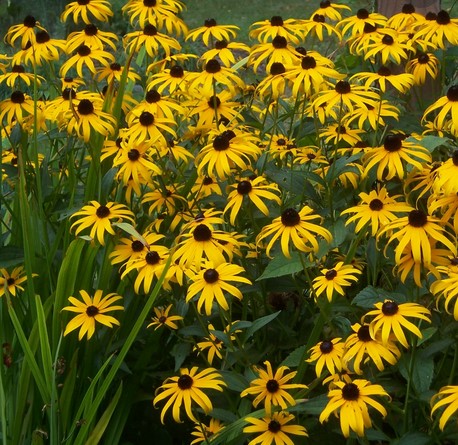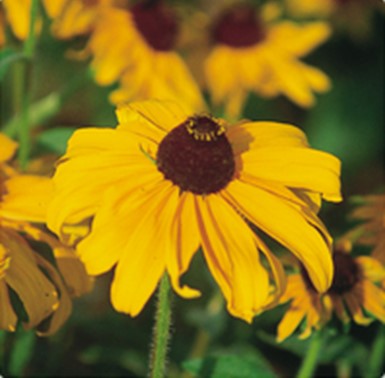Black-Eyed Susan
Rudbeckia hirta


Characteristics
- Type: Tender perennial
- Zone: 3 – 7
- Height: 1 – 3 Feet
- Spread: 1 – 2 Feet
- Bloom Time: May – November
- Bloom: Yellow to Orange-Yellow Rays & Dark Brown Centers
- Sun: Full sun
- Water: Medium
- Maintenance: Low
- Suggested Use: Annual, Naturalize
- Flower: Showy
- Attracts: Butterflies
- Tolerate: Deer, Drought, Clay Soil
- Texas Native
- Henderson County Native
Culture
A biennial or short-lived perennial, Black-Eyed Susan is winter hardy to USDA Zones 3-7. It blooms in the first year from seed planted in early spring, and is accordingly often grown as an annual. It is easily grown in average, medium moisture, well-drained soils in full sun. Best in moist, organically rich soils. Tolerates heat, drought and a wide range of soils except poorly-drained wet ones. Some varieties are available in cell/six packs from nurseries. Set out seedlings or purchased plants at last frost date. Deadhead spend flowers to encourage additional bloom and/or to prevent any unwanted self-seeding. Whether or not plants survive from one year to the next, they freely self-seed and will usually remain in the garden through self-seeding.
Noteworthy Characteristics
Ruudbeckia hirta, commonly called black-eyed Susan, is a common Texas native wildflower which typically occurs in open woods, prairies, fields, roadsides and waste areas throughout the State. It is a coarse, hairy, somewhat weedy plant that features daisy-like flowers (to 3” across) with bright yellow to orange-yellow rays and domed, dark chocolate-brown center disks. Blooms throughout the summer atop stiff, leafy, upright stems growing 1-3’ tall. Rough, hairy, lance-shaped leaves (3-7” long). Plants of this species are sometimes commonly called gloriosa daisy, particularly the larger-flowered cultivars that come in shades of red, yellow, bronze, orange and bicolors.
Problems
No serious insect or disease problems. Susceptible to powdery mildew. Watch for slugs and snails on young plants. Can self-seed freely. Deer tend to avoid this plant.
Garden Uses
Borders. Annual beds. Cottage gardens. Wild gardens. Meadows. Groups or mass plantings. Good cut flower.
Courtesy of Lady Bird Johnson Wildflower Center